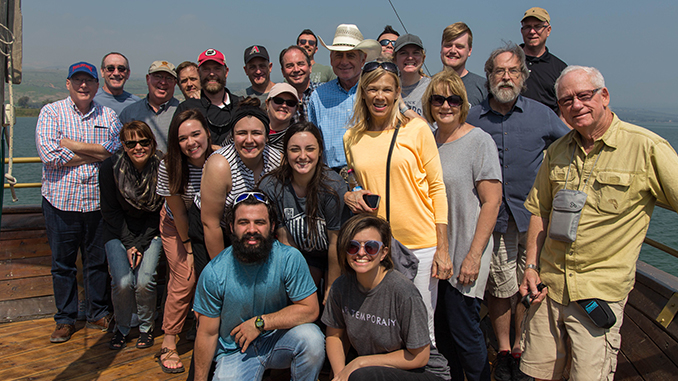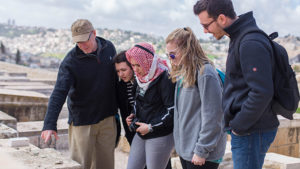
The prophet Micah wrote these words: “And many nations shall come, and say, ‘Come, and let us go up to the mountain of the LORD, ….’” (4:2) During Spring Break 2018, a group of 25 BBC students and members of High Street Baptist Church were joined by 13 other BBFI pastors, missionaries and church leaders from the US, Europe, and Africa on an Israel study trip. Professors Ray Adams and Craig Dunning led this group on an amazing journey “up to Jerusalem” and throughout the land. “It was so nice to see the BBC students and BBFI family mixing so well. This is an important connection that we want to maintain. We are planning to do this again in two years,” states BBC President Mark Milioni, who also went on the trip.
Upon landing in Tel Aviv, the students were in sensory overload. For several months the anticipation of going to Israel had built up, then anticipation transformed into amazement: “I can’t believe we are actually here,” some students were overheard saying in the airport.
Professor Dunning distinguished this study tour from the countless other groups making the similar journey: “Many groups approach a trip to Israel as a checklist: ‘We’ve been here, here, and here.’ And, while every trip to Israel likely has some element of that, this study tour specifically focused on connecting the locations with the reality and reliability of God’s word.” That happened, for example, at the Pool of Siloam where the blind man’s sight was restored. It happened on the Southern Steps of the Temple Mount as the group considered the Psalms of Ascent as was done by the ancient Jews. After walking the Palm Sunday route and visiting the Garden of Gethsemane, President Milioni focused the group’s attention on the death, burial, and resurrection of our Lord at the Garden Tomb. “Really, the main thing to say is, ‘He’s not here; he’s risen!” Milioni concluded.
One student was so struck when it occurred to him that he was walking the pages of the Bible that he exclaimed, “Think about it! What percentage of the world can say they have walked through Hezekiah’s Tunnel? This place is real!” Reflecting on this student’s reaction, Professor Adams said, “It’s such a joy to see first timers connect the location with the Bible.”
 Because BBC is still in the business of training students for vocational ministry, another highlight of the Jerusalem portion of the study tour was visiting the local church that Dunning helped plant over twenty-five years ago. “Once again, we were able to connect the location to the text as we saw the modern application of Jesus’ command to make disciples of all nations,” Dunning explained.
Because BBC is still in the business of training students for vocational ministry, another highlight of the Jerusalem portion of the study tour was visiting the local church that Dunning helped plant over twenty-five years ago. “Once again, we were able to connect the location to the text as we saw the modern application of Jesus’ command to make disciples of all nations,” Dunning explained.
The group moved from Jerusalem to Galilee via the Jordan River Valley, which gave us opportunity to see Qumran, Ein Gedi, Masada, the Dead Sea, and Jericho. After a long day traveling north, they got settled into their rooms on the shore of the Sea of Galilee. The long travel day notwithstanding, no one could remain in their rooms. What a wonderful site to see Christians gazing over the Sea of Galilee, reminiscing about the familiar stories from the gospels. It was here that Jesus calmed the storm. It was here that Jesus walked on the water. It was on the shore of this lake that Jesus called his first disciples. A pastor in the group described it this way: “Just standing and viewing the places where the Bible stories took place was inspiring.”
President Milioni used three words to describe this trip: “Beautiful. Powerful. Emotional. These words are just a beginning of what our trip to Israel meant. Beautiful sights, sounds and smells. Powerful connection to where the Bible took place. Emotional feelings each and every day as we connected where Jesus lived and healed and taught and died and rose for us.”
Over the final three days, the group stood on the steps of Jeroboam’s high place at Dan, roamed around Caesarea Philippi, rafted on the Jordan River, sailed across the Sea of Galilee, considered the life and ministry of Jesus at Capernaum, and so much more. Although Adams and Dunning managed to pack a lot into this study tour, there remains much more to see. So, as Jews around the world say at the close of the Passover meal, “Next year in Jerusalem.” Let’s do this again.
